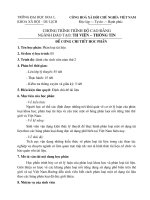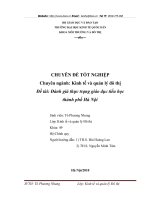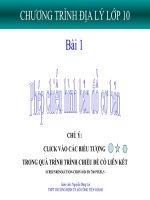E8 U 2
Bạn đang xem bản rút gọn của tài liệu. Xem và tải ngay bản đầy đủ của tài liệu tại đây (98.46 KB, 9 trang )
<span class='text_page_counter'>(1)</span>UNIT 2: MAKING ARRANGEMENTS Division of lessons 1. Getting started + Listen & read 2. Speak + Listen 3. Read 4. Write 5. Language focus. Unit2 : Lesson 1. Getting Started +Listen & Read I.. Aim: By the end of the lesson , Ss will be able to use the telephone to make and confirm arrangements II. Language contents a/ Grammar: Future with “ be going to” b/Vocabulary: none III. Techniques : Matching, Open- prediction, Role-play, Guessing game IV. Teaching aids: textbook, poster, pictures V. Procedures:. Teacher & Ss’ activities T asks Ss to look at 6 pictures and asks some questions SS work in pairs, matching each objects ( pictures on page 18) with its names. T calls some pairs to check the answers. T gives the definitions of these objects on a poster and asks Ss to match the objects with its definition Ss work individually. Contents 1.Warm up What is this? When do you use it? Keys: a. an answering machine b. a mobil phone c. a fax machine d. a telephone directory e. a public telephone f. an address book Definition 1. 2. to send fax 3. tofind someone’s telephone number 4. to write addresses and telephone number 5. to make a phone call in a street telephone 6. to leave and take message 7. to make phone call anywhere you like Keys: aï5,b6,c1,d2,e4,f3.
<span class='text_page_counter'>(2)</span> T sets the scene” Hoa and Nga are taking on the phone.They are talking about going to see a movie” T ask SS to guess Ss guess who did those things. T asks Ss to listen to the tape Ss check their guessing T asks some questions. Ss play roles of two Ss who are talking on the phone making arrangements Ss change the information. 2.Presentation Wh o a.made the phone? b.introduced herself? c.invited the other to movies? d. arranged a meeting place? e.arranged the time? f.agreed to the time?. Guess Keys Nga Nga Nga. Nga. Hoa Nga. 3.Practice Questions a/What is Hoa’s telephone number? b/Which movie arethey going to see? c/How is Hoa going to the movies? d/ Where arethey going to meet?What time? 4 .Production: Lan and Lien are making arrangements to go to the movie.They are going to see a cartoon.It’s“Snow White and the Seven Dwarfs” 5.Homework: -Do exercise 1 in workbook page 13 -Prepare lesson 2 : Speak+ focus 1,2. COMMENTS: ………………………………………………………………………………………………………………………………………………………………………………………………………………… …………………………………………………………………………………………………………………………………………………………. UNIT 2: Lesson 2. Speak + listen.. I.Aim: By the end of the lesson, SS will be able to talk on the telephone about intentions with GOING TO. students will be able to complete a telephone message by listening and further practice in adverbs of place II.Language contents a/Grammar: S +be+ going to+ Infinitive b/ Vocabulary: none III. Techniques:Chatting, Word cue drill, Role-play. IV. Teaching aids:Textbook, cards , tape ,cassette. V. Procedures:.
<span class='text_page_counter'>(3)</span> Teacher & Ss’activities T asks Ss about using telephone T asks some questions. T asks Ss to read the sentences in exercise 1 on page 20 T asks SS to guess. Ss put the sentences in the correct order to make a complete conversation Ss work in pairs T asks some questions to check Ss’ understanding and focus on the structure GOING TO I can give marks. Contents 1.Warm up * Chatting 1/Do you have a telephone at home? 2/How often do you make a phone call ? 3/What would you say when you pick up the phone to answer it? 4/What would you say if you are the caller? 2.Pre- speaking .Who is making the phone? .Who is answering the phone? Answers: 1b,2f,3j,4a,5i,6c,7e,8k,9g,10b,11d. I can give the form. *Questions: .Are they talking on the phone? .What do they intend to do? .What time are they meeting? .What forms of the verbs do you use to talk about intention? *Form: S+be +going to+Infinitive *Use: Express an intention 3.While-speaking. Teacher asks Ss to read the open-dialogue and introduces about Bao and Ba: “Bao and Ba are making arrangements to play chess” Ss work with their partners to complete the dialogue Ask Ss to play the roles of Ba and Bao to practice the dialogue Ss practice Teacher corrects. Suggested keys: Bao:May I speak to Ba, please?This is Bao. Bao:I’m fine, thanks.And you? Bao:Can you play chess tonight? Bao:What about tomorrow afternoon? Bao:I’ll meet you at the Central Chess Club. Bao: Is 2.00 o’clock OK?. Let students work in pairs Give feedback. Teacher asks Ss to write five things that they intend to do next week.
<span class='text_page_counter'>(4)</span> listen. Teacher divides students into two teams Teacher chooses 6 volunteers from each team The volunteers stand in two lines. The teacher shows the first student in each line a telephone number He whispers the telephone number to the next person in his line The last student shouts out the number if it is the same as the number teacher shows, that team wins the match Teacher asks students to look at the form of the telephone message on page 21 and set the scene “a woman phoned the principal of Kingston junior high school, but he was out” Teacher introduces some new words. 1. Warm up( 10’) Telephone transmitting. 2. Pre- listening. Teacher asks students to guess the message Let Ss work in pairs Get Ss to listen to the tape twice Students listen and fill in the message Students compase with their guess. New words: -message(n) -principal(n) -appointment(n). 3. While- listening( 10’) Teacher asks students to play “Jumbled words” Teacher asks students to give the meaningful words Let them work individually, one student one word. Teacher asks Ss to do exercise 3 on page 26 Teacher sets the scene: “Ba is playing hide and seek with his cousin, Mr Tuan” Students work in pairs At last, teacher gives the keys. Teacher asks students to read out the speech bubbles. Answers Date: Tuesday Time: 9.45 For: the principal Message: Mrs Mary Nguyen wanted to see you at 9.45 in the morning Tel number: 64683720942 4. Post (10’) Jumbled words 1.tdeousi 4. erhe 2. siiden 5. stupairs 3. hetre 6. wonstairds Answers 1. outside 3. there 5. upstairs 2. inside 4. here 6.downstairs.
<span class='text_page_counter'>(5)</span> Eg: My room is upstairs Answers b/ here c/ downstairs d/ outside e/ there f/ inside. 5. Homework -Write six sentences about your house, using adverbs of place. -Do exercises 5,6 in workbook -Prepare: Lesson 4 Write COMMENTS : …………………………………………………………………………………………………………………………………………………………………………………………………………………… ………………………………………………… UNIT 2: Lesson 3 READ I.Objectives: By the end of the lesson, SS will be able to know more about Alexander Graham Bell. II.Language contents: a/ Grammar: Simple past b/ Vocabulary: emigrate(v) transmit(v) conduct(v) demonstrate(v) a device a deaf-mute III.Techniques: What & Where,T/F statements prediction, Ordering IV.Teaching aids: textbook, poster, picture of Bell V.Procedures: Teacher and Ss’ activities T lets Ss answer the questions by coming to the board and write. Contents 1.Warm up (5’) Marks *Brainstorming What is the telephone used for?. Ss write the answer on the board. T corrects and can give possible answers.. T introduces some new words Ss listen and guess the meaning T explains the words by using simple English T has Ss repeat the words in chorus. .To have a message .to talk to a person who lives far from .to call someone .to make arrangements .to get information at the airport 2.Pre- reading(15’) @Pre-teach vocabulary emigrate(v): go to another country to live transmit(v) conduct(v)=carry out demonstrate(v)->demonstration(n).
<span class='text_page_counter'>(6)</span> T checks Ss’memory T hangs the poster of T/F statements on the board Ss work in pairs Ss guess which statements are true or false. T asks Ss to read the text on page 21,22 and check their prediction T has Ss correct false statements Ss write the true statements on the board T gets Ss to read the events of Bell’s life and put them in the correct order. Ss compare with their partners T gives the key T gets Ss write a paragraph about Bell’s life, using the information from the text Ss work individually. If Ss do well, T can give marks. a device(n) a deaf –mute: a person who is unable to hear and speak What & Where II.T/F statements prediction a/Alexander G. Bell was born in the USA b/He works with deaf-mute patients in a hospital in Boston c/Thomas Watson was Bell’s assistant d/Bell and Watson introduced the telephone in 1877. e/Bell experimented with ways of transmit speech between deaf-mutes over a long distance f/ Bell demonstrated his invention at a lot of exhibitions. 3.While-reading(15’). Ordering Alexander Graham Bell 1d 2e 3a 4g 5c 6b 7f. 4.Post –reading (12’) Writing it up *Suggestion: Alexander Graham Bell was born on March 3rd , 1847 in Scotland.He went to live in Canada and then to the USA in 1870s.He worked with deaf mutes at Boston University and did experiments with ways of transmitting speech over a long distance.In 1876,he and his assistants-Thomas Watson introduced the telephone successfully and in 1877 the first telephone was in commercial use 5.Homework(3’) -Learn the new words by heart -Do exercise 5 in workbook -Prepare lesson 5 Write. Remarks: ………………………………………………………………………………………………………………………………………………………………………………………………………………… ……………………………………………………………………………………………………………………………………………………………... UNIT 2: Lesson 4 WRITE.
<span class='text_page_counter'>(7)</span> I.Objectives: By the end of the lesson, Ss will be able to write a telephone message II.Language contents: a/Grammar: Simple Past b/Vocabulary: A customer a delivery stationary pick someone up III.Techniques: Chatting, Gap- filling , Rub out and Remember IV. Teaching aids: textbook, sub- board. VI. Procedures: Teacher and Ss’ activities T asks Ss some questions. T asks Ss to talk to a telephone message Ss talk to one another. T presents some words Ss repeat and copy. T asks Ss to read the message and fill in the gaps in the passage on page 23. Let Ss work in pairs. Ss give the answers T gives feedback.. T asks Ss to read passage 2 on page 23 to get information and write the message. Let Ss write individually then share with a partner.. T asks Ss to write another message T sets the scene :” Tom phoned Nancy, but he was out.Lisa, Nancy’s sister took a message for Nancy. Help Lisa to write a message.” Ss read the dialogue between Lisa and Tom then write a message.. Contents 1.Warm up (5’) Marks Do you have a telephone number? How often do you make a phone call? Have you ever taken a telephone message? When you take a message, what should be mentioned in the message?(Date, time, who sent, to whom, content) 2.Pre- writing(10’) Pre- teach vocabulary a customer: a person who comes to buy something at a shop a delivery stationary(n) ( example: paper, pens) pick someone up Rub out and remember 3.While-writing(15’). Answers: (1)phoned (2)May 12 (3)speak (4)took. (5) name (6) delivery (7) Mr Ha (8)at. Answers: Thanh Cong Delivery Service Date: June 16 Time; After midday For: Mrs Van Message: Mr Nam called about his stationary order.He wanted you to call him at 8634082. Taken by: Mr Toan 4. Post- writing(10’). Answers: Date: ( ).
<span class='text_page_counter'>(8)</span> Ss work in pairs. T can guide Ss to write the message. Time; ( ) For: Nancy Message: Tom called about playing tennis this afternoon.He will come over to pick you up at 1.30 Taken by: Lisa 6. Homework(5’) -Learn new words -Do exercise 7 in workbook -Prepare: Unit 3 Listen and read. Language focus Objectives: This period helps Ss to review the grammar points of unit 2 and do some more exercises. II. Language contents: a/ Grammar: 1.Future with be going to 2.Adverbs of place b/ Vocabulary: Unit 2 III. Techniques: Gap – fill ,Matching, Jumbled words IV.Teaching aids: Sub-boards, cards V.Procedures: I.. Teacher and Ss ‘s activities T holds class to play game Ss work in groups T corrects. T reviews how to use”be going to” Ss give examples. Ss give examples with adverbs of place SS do others exercises Ss work individually. Ss write the sentences on their notebooks. Contents 1. Warm up (5’) Jumbled words 1.mcuestor = customer 2. ayddmi =midday 3. essgmea = message 4.nifurretu = furniture 5. rvseice = service 2.Pre-teach (10’) Be going to + V( infinitive) ->Talk about intention Ex: I bought a pair of boots because I’m going ( to go) skiing this Sunday. Adverbs of place: Ex: Don’t go outside , it’s too cold. 2. While(15’) Marks I.Complete the sentences , using the appropriate adverbs : in , on, there,outside,inside,upstairs,here,down -stairs. 1/ The children love Disneyland. They want to go …. again. 2/ I opened the box and look…. 3/ She ran…. to open the door for him. 4/I’m afraid I can’t drink coffee with milk ….. 5/Let’s go… and sit in the sun. 6/Wait…..I’ll be back in a minute. II.Complete the second sentence so that it has a similar meaning to the first..
<span class='text_page_counter'>(9)</span> Ss rewrite the sentences If Ss do well, T can give marks. Ss give the correct form of the verbs T gives feedback. T asks Ss to rewrite the sentences as directed in parentheses. 1/ I intend to come over to pick you up. ->I am………………………………… 2/Nam is good at swimming -> Nam swims…………………………… 3/Do you want to come for dinner tonight? -> Would you……………..? 4/ She doesn’t go to the movies because she has no time. ->She doesn’t have…… III.Supply the correct form of the verbs 1/They usually go (fish) at weekends 2/I (see) a movie tonight. Would you like (come) ……? 3/Do you have (be) on duty today? 4/ Bell and Watson first (introduce) the telephone in 1876. 5.Ba can’t play soccer tomorrow. He (do) his homework. 4.Post (10’) Do as directed in parentheses: a/Tom is one of my (friendly)….He always talks to everyone in a (friend) way (Give the correct form of the word) b/Where is the film…?At the Rex theatre. ( use the suitable preposition) c/He worked with deaf-mute. (make a question for the underlined word) d/Deaf-mutes can… speak…hear. (both..and; not only.. but also; neither... nor) 5.Homework (5’) -Do exercises again -prepare:Unit 3 Listen & read.
<span class='text_page_counter'>(10)</span>









